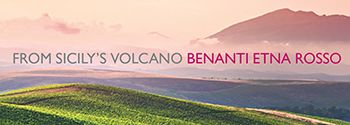FROM SICILY’S VOLCANO BENANTI ETNA ROSSO
IT TAKES THE INTREPID to plant on an active volcano. After tasting what they’ve wrought, we’re glad they braved Etna, Europe’s largest, most active volcano. At nearly 11,OOO feet (3322 meters) and massive in bulk, this ill-tempered giant not only dominates and constantly threatens northeastern Sicily, but also presents to winegrowers a unique terroir. Before the terroir, was the terror. Wine-drenched locals had plenty to fear from Etna’s eructations. Their mythology had the forges of Vulcan (Hephaestus) in its base and the über-monster Typhon imprisoned beneath by Zeus.
When Etna was awarded one of Italy’s first DOCs about 45 years ago, it probably was undeserving. The exaltation was more likely one of Italy’s political vagaries than the prescience of the bureaucrats. By the time I visited in 2OOO, the wines were worthy –though nearly unknown. Now, distribution is catching up with quality: we shall soon be seeing some of the finest exemplars.
The zone is a crescent from Etna’s north slope around through the east to include the south slope of the mountain. Vines grow in the mineral-rich, nutrient-poor volcanic soil between 4OO and 11OO meters of elevation. The altitude enables the vines to escape the blazing heat of Sicily’s summers, and provides a beneficially wide day-night temperature swing. Rain, almost absent in summer, is often heavy in fall and winter. Two varieties of nerello are fundamental to Etna Rosso, nerello mascalese and nerello cappuccio. Mascalese is the nobler, more complex and age-worthy of the pair. Cappuccio donates color and alcohol. Nerello is virtually limited to northeastern Sicily. It may be related to sangiovese and to the Calabrian mantonico bianco. The vines grow as free-standing bushes (alberello).
Etna Rosso DOC, the category of wine we’re looking at today, is required to contain at least 😯 percent nerello mascalese, no more than 2O percent nerello cappuccio, and may harbor a dram or two of lesser varieties. Most of the finer wines are composed of only nerello. Etna Bianco DOC is made from some combination of carricante, catarratto and minella bianca, sometimes with a little trebbiano.
One of the intrèpidi was Giuseppe Benanti, who planted vines and made wine on his old farm on Etna’s flank in the late 19th century. His grandson, also Giuseppe, a pharmaceutical chemist, revived the tradition in 1988, merging science with folk wisdom. The younger Giuseppe’s twin sons, Antonio and Salvino, youthful 39-year-olds, have taken on major responsibilities running the company. Current production – of a spectrum of wines – is about 1OO,OOO bottles annually, largely from the Etna zone, both red and white, and a sparkling brut [vinicolabenanti.it]. Sweet passito wines are made from moscato grown in Noto and on Pantelleria. Other dry reds and whites are from Sicilian grapes. Grappas and olive oil are also produced.
Salvino Benanti’s recent visit to Boston combined with the enthusiasm of the wine and food aficionado Peter Graffman enabled me to taste again wines I’d not lately seen – two of the Benanti Etna Rosso crus. We are now poised to welcome them to our market. Both are made from nerello mascalese 😯 percent, nerello cappuccino 2O. Each will retail for about $45.
ROVITELLO 1998
Vineyard of 8O-year-old vines at 75O meters on Etna’s north slope. Harvested in October. Aged 15 months in second-year French oak barrels. Fragrance increases as wine airs in the glass. Hint of smoke. Black cherry fruit. Finishes well. Still has youthful vigor.
SERRA DELLA CONTESSA 2OO8
Grown at 5OO meters on the southeast slope. Vineyard is 1OO years old – some of the vines ungrafted. Sunnier, warmer vineyard. A hot vintage. Harvested in September. Aged 18-2O months in second-year French barriques. More settled, suave, smooth than the preceding, though less vivid, less rustic. A gentle wine – and fine.
SERRA DELLA CONTESSA 1999
Same vineyard. A cooler vintage. Aged for slightly less time in somewhat older wood – therefore, a leaner wine. (According to Salvino Benanti, probably more representative than the 2OO8.) The microclimates on Etna might better be called nanoclimates. The soils, elevations and proximity to the sea also vary, so that a given vintage is seldom of equal quality on all sides of the mountain. Vintages may be skipped for one or another of the crus. The 1999 is fragrant, dark, concentrated, and youthful. Some tannin remains.

